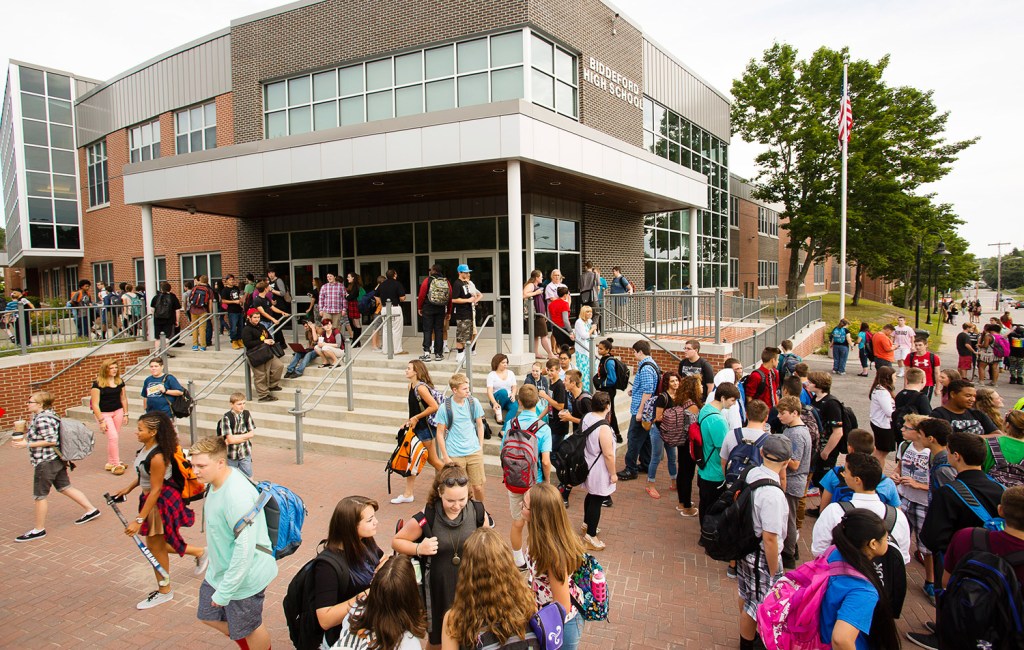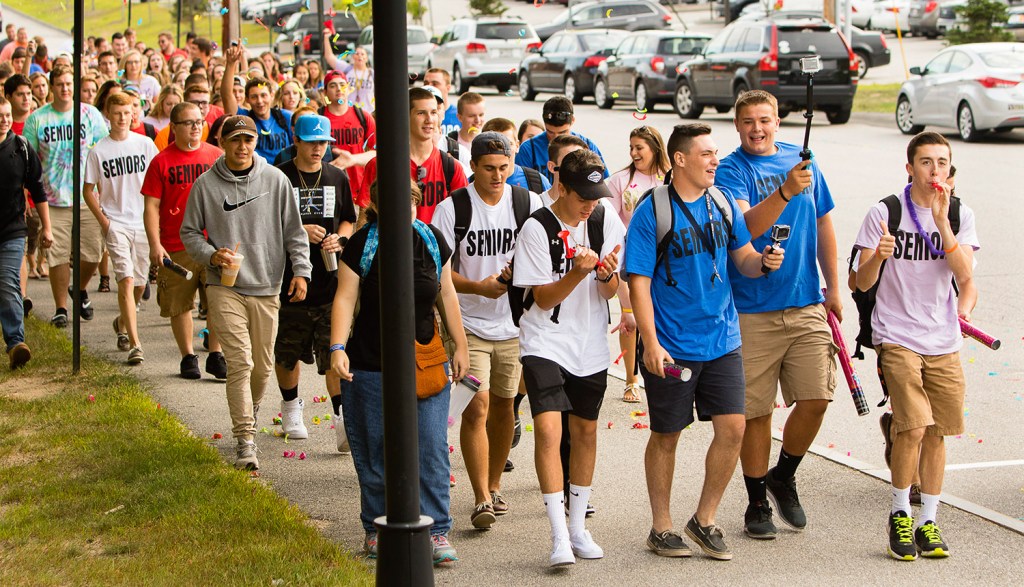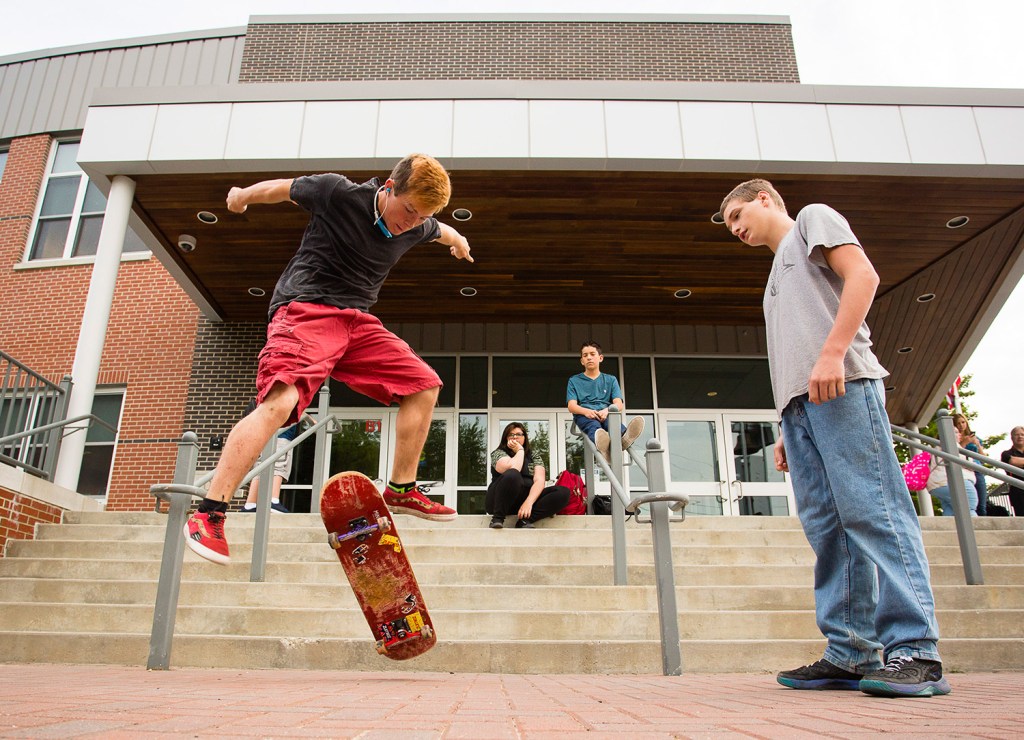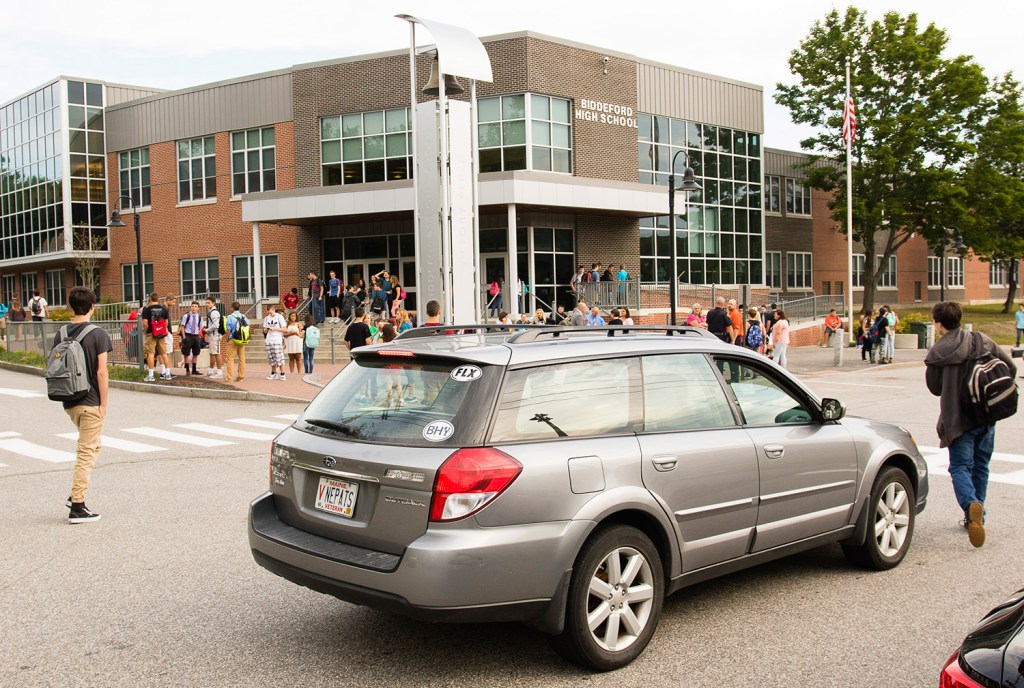Angel Brecht and Vanessa Benwell, both juniors at Biddeford High School, were getting their morning jolt at Dunkin’ Donuts last week, but they said they don’t need it as much this year.
That’s because Biddeford High School – and other school districts like Saco, Old Orchard Beach, Yarmouth and SAD 51, which serves students in Cumberland and North Yarmouth – all moved their start times later this year. It’s part of a national movement to have older students start school later, based largely on recommendations from the U.S. Centers for Disease Control and Prevention and the American Academy of Pediatrics that middle and high school students start school at 8:30 a.m. or later.
Numerous studies have found that teenagers simply need more sleep, and later school start times improve student health and ability to learn.
Brecht didn’t need a scientific study to tell her what she already knew from personal experience.
“It was so draining last year,” when school started at 7:35 a.m. and she tried to focus in geography, her first class of the day. Now that she doesn’t even need to be awake at that hour – because school starts a full hour later at 8:30 a.m. – “I like it.”
According to the latest available CDC report on the topic, Maine’s average high school start time is 7:53 a.m., 10 minutes earlier than the national average of 8:03 a.m., and many Maine high schools start at 7:30 a.m. or earlier. Nationally, at least 200 schools have instituted later morning start times over the past few years.
“It really is a milestone,” said Tracey Collins, a Saco parent who lobbied for the change after watching her then-sixth grade daughter struggle in the morning to get up in time to catch a 6:45 a.m. bus. “It was like having an infant again, helping her put her shoes on,” she said and laughed.
Now her 11-year-old son is showing signs of the body clock switch that flips around age 12.
“I noticed it this summer. He’s sleeping in later and later,” said Collins, who heads up the Saco chapter of Start School Later, a national advocacy group that helps local parents advocate for the change and provides materials to share with local school officials.
Knowing there’s a scientific explanation to why her children are so groggy in the mornings actually helps her as a parent, she said. “It’s biological.”
TEENS NEED MORE SLEEP THAN ADULTS
Numerous research studies have proved that early starting times for teenagers are harmful to their health, because the developing brain is wired differently than an adult’s. For a teenager’s brain, 7 a.m. is equivalent to 4 a.m. for an adult, according to the CDC. Also, teens need more sleep than adults, at least 8½ hours compared to seven hours for an adult. In addition, teens’ biological clocks mean they feel sleepy later in the evening than elementary school students, which is why many teens have a difficult time falling asleep before 11 p.m.
That means teenagers, unlike adults, cannot simply go to bed earlier and still be alert at the beginning of the school day, according to the CDC.
Starting school early has led to higher rates of adverse health problems, including obesity and depression, and has also been shown to lead to more frequent car accidents when drowsy teens drive to school, according to the CDC. In addition, sports performances are compromised when students get too little sleep, as reaction times decline and the body does not heal as well from sports injuries.
Studies correlate improved student performance to well-rested teens, especially during morning classes, and reduced use of drugs and alcohol, according to scientific research.
But not everyone is thrilled with the change.
Later start times pose a logistical problem for some families, and Biddeford High sophomore Harmony Coolbroth said it interferes with sports practice after school. “I don’t like it. It’s too much,” she said, before acknowledging, “I like to sleep in.”
Saco Superintendent Dominic DePatsy said he spent a lot of time last year going to meetings and explaining the benefits of later start times.
Like other school superintendents, he made adjustments to accommodate parents who, for example, had to drop off children earlier because of their jobs.
Saco’s bus schedule was adjusted, and the middle school opens at 7:30 for early drop-off students. Changes to the middle school class schedule created more professional development time for teachers without losing instructional time for students, he said.
“We’re ready to rock and roll,” DePatsy said.
Last year, to test the idea, he had school officials pair up with students of varying academic abilities for the first part of the day, observing them through the first few periods of the day. They saw a big difference in the students’ ability to concentrate between the first and second periods of the day, and whether they were low- or high-performing students made no difference.
“It affects them all the same,” DePatsy said. “You see them walking like a zombie during that first class, then follow them to second, you see it.”
He said he sees the shift in his own teenagers. “It’s crystal clear.”
DIFFICULT DECISION MADE EASY
The school boards of Biddeford, Saco and Dayton made a joint decision to start the school day later. Old Orchard Beach, which had already shifted its start times for the middle and high schools from 7:30 to 8 a.m. last year, moved it again, to 8:30 a.m., this fall for middle and high school students.
Old Orchard Beach Superintendent John Suttie said it went so well last year, it was easy to adjust the start time again this year.
“Last year we saw a huge difference, just walking through the halls,” said Suttie, who also serves as principal of the high school. “They are so much more alert and ready to learn.”
Suttie said he was surprised that when he spoke to students’ families, they weren’t focused on the science.
“It was about whether it was an inconvenience. If it was, they were against it,” he said. “That’s where we, as educators, have really got to make a decision.” But once they reviewed the studies, it wasn’t a hard decision.
“It was easy for us to make a difficult decision,” he said. “I thought it was a very courageous act.”
A student survey in Old Orchard Beach after the move to 8 a.m. found that 70 percent of the district’s high school students believed the later start times had a positive effect on their school day. An informal survey of parents during parent-teacher conferences also found support, officials said.
Some districts are still considering later start times.
In South Portland, where the high school starts at 7:30 a.m. and the middle schools start at 7:55 a.m, the school board voted in July to have a committee study the matter. But they based that vote on a school survey that found most parents and staff agree with the idea of a later start time.
Westbrook and Cape Elizabeth have also adopted later start times in recent years.
Changing school hours, for whatever reason, is disruptive, officials acknowledge. Classroom teaching time, the hours teachers work under their contracts, bus schedules and students’ after-school sports, jobs and child-care issues are all factors. In Portland, a decision to add 20 minutes of teaching time to the school day set off bus schedule changes that angered many parents and forced the district to change school start times again the following year.
The impact on sports, and the ability of students to travel to regional academic programs, are frequently raised as concerns when neighboring schools don’t have the same schedule. Sports practice and game schedules are a bigger issue in rural areas where teams have longer travel times.
That’s one reason a regional approach helps. In SAD 51, Superintendent Jeff Porter said he consulted with neighboring superintendents before making a “conservative” shift in school start times, with sixth-grade and older students moving from 7:30 a.m. to 8 a.m., and younger students moving from 8:30 to 8:45 a.m.
“I am absolutely happy we did it,” Porter said. “It’s absolutely the right thing to do.”
The move coincided with Greely High School changing to a classroom schedule that shortens the school day slightly, but does not reduce instructional time. Students now have four 84-minute block classes per day, replacing seven 50-minute-long classes previously.
Porter said a survey last year found that about 80 percent of 1,300 respondents in SAD 51 supported the move.
“It was a huge percentage of people,” he said. “That helped our committee feel like it was doing the right thing.”
HOPING TO LOWER RATE OF TARDINESS
In Biddeford, officials said they saw the difference immediately.
On Thursday, the second day of school, dozens of students were milling around the front of Biddeford High School at 8:20, chatting with friends, trying out skateboard moves and just hanging out.
It was a bit surprising for Superintendent Jeremy Ray. “This never happens,” he said, looking around at the buzzing crowd waiting for the bell to ring and the school doors to open. Next to him Principal Jeremie Sirois smiled and nodded his agreement.
“You see kids come to life right around 8:15, 8:20,” Ray explained. Last year, when school started earlier, they were more likely to see students rolling in just as the bell rang, with “a line of students out the door” marked as tardy because they’d arrived late. He’s hoping the time change will lower the tardy rate.
Sirois said the school had to make some changes to make the later start time work: He shifted the teachers’ contract slightly, since teachers are coming in later and leaving later, and he doesn’t allow any meetings before 8 a.m., so teachers aren’t obliged to be at the school “early.”
The after-school impact, even on sports, is minimal because Biddeford has two indoor gyms and the fields have lights.
Biddeford High junior Julia Pearl said she likes the change, which gives her more time to get ready for school and have breakfast at home.
“I feel like I’m not as rushed,” said Pearl, 16. “I think we’ll all be more awake in class.”
That was a problem for sophomore Alyssa Landry last year, when her first class of the day was freshman math.
“I was just so tired. I was so out of it,” said Landry.
Her mother, Michele, said she didn’t support the change at first. But after attending the meetings, that changed.
“I realized it was just a science thing,” she said.
Send questions/comments to the editors.









Success. Please wait for the page to reload. If the page does not reload within 5 seconds, please refresh the page.
Enter your email and password to access comments.
Hi, to comment on stories you must . This profile is in addition to your subscription and website login.
Already have a commenting profile? .
Invalid username/password.
Please check your email to confirm and complete your registration.
Only subscribers are eligible to post comments. Please subscribe or login first for digital access. Here’s why.
Use the form below to reset your password. When you've submitted your account email, we will send an email with a reset code.